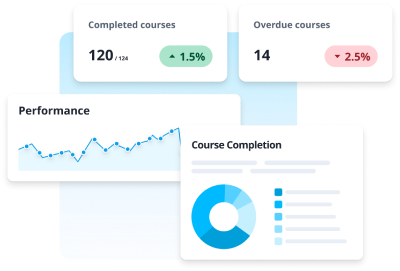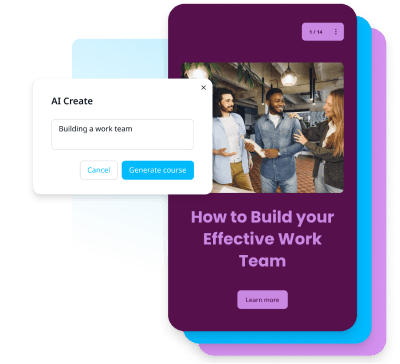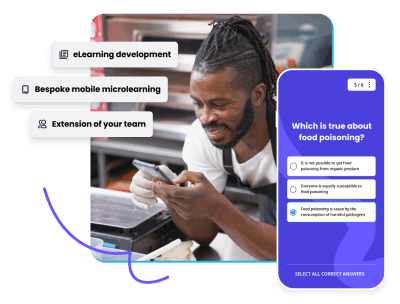How to create effective training modules for corporate training

Training modules help your employees develop skills and knowledge they need to excel in their roles. These modules play a vital role in enhancing their work performance, fostering professional growth, and driving the success of the organization.
In this article, you'll discover how a well-made training module can revolutionize your corporate training approach. This can make your team’s learning journey engaging, practical, and tailored to their needs.
What is a training module?
A training module is a structured and focused learning resource about specific knowledge, skills, or competencies for employees within a company or organization. It’s a key component of corporate training programs and serves as a building block for professional growth and development.

These modules are carefully made to address particular learning objectives like improving communication skills, developing technical proficiency, or fostering teamwork. They also guarantee that your employees will gain the necessary knowledge and capabilities to excel in their roles and contribute to your organization's success.
Training modules are often integrated with Learning Management Systems (LMS). EdApp is an LMS that can help facilitate the administration, tracking, and reporting of your learners' progress.

With EdApp, you can streamline your training process. With its easy-to-use Creator Tool, you can create captivating microlearning courses with bite-sized lessons for your team’s training needs. You don’t even need to start from scratch since its AI Create feature can help you generate a whole training module with just the click of a button.

If you need extra help, EdApp’s Course Creation Services will also lend an expert team of instructional designers to make engaging lessons for your team. The platform also offers reporting and analytics to measure training effectiveness and identify areas for improvement.

Sign up to EdApp for free to enhance the overall management and delivery of your training module.
Characteristics of a Training Module

It helps to know these training module characteristics so you can make sure that your training materials have these features to enhance your team’s learning experience. Here are the characteristics of a training module for corporate training:
- Relevance: Training modules contain relevant and valuable lesson content related to the specific subject matter.
- Accessibility: Consideration for accessibility guarantees that all employees, including those with disabilities, can access and benefit from the training content.
- Interactivity: Interactive elements, such as quizzes, exercises, and simulations, make the training engaging to improve knowledge retention.
- Adaptability: Modules must be designed to adapt to the learner's pace, allowing employees to progress at their own speed.
- Updatability: Training modules need periodic updates to reflect changes in the industry, best practices, or company policies.
Common training module formats
Training modules are delivered in various formats. These formats cater to different learning styles and objectives. You can also combine multiple training module templates to create a more comprehensive and engaging training experience.

The choice of training module format depends on your content, target audience, available resources, and desired level of engagement. Here are some common formats you can choose from:
- Presentation Slides: This is a traditional format where information is presented using slides with text, images, and graphics. This example of a module is useful for conveying concepts and giving a topic overview.
- Videos and Webinars: These pre-recorded videos or live webinars feature subject matter experts or trainers delivering the content. Videos are engaging and demonstrate real-life scenarios.
- Podcasts and Audio Modules: Audio-based training content can be accessed conveniently. As an example of training design, this can be great for learners on the move.
- Elearning Courses: These comprehensive digital courses include multimedia elements like videos, animations, quizzes, and interactive activities. Elearning courses are flexible and accessible online.
- Gamified Modules: Incorporating game elements like points, badges, and challenges makes learning more enjoyable and incentivizes participation and progress.
- Microlearning Modules: These short, bite-sized modules focus on specific topics. Microlearning is ideal for on-the-go learning and knowledge reinforcement.
- Simulations: Interactive virtual environments allow learners to practice skills and decision-making in a risk-free setting. Simulations are valuable for training in complex or high-stakes situations.
- Augmented Reality (AR) and Virtual Reality (VR): These immersive technologies simulate real-world experiences. They’re particularly useful for technical training and complex simulations.
Steps to create an effective training module
Creating an effective training module involves a systematic approach that addresses the specific needs of your learners. Engagement, accessibility, and continuous improvement are the top priorities for employee training guides. Let's discuss each step in detail.

- Understand Your Team's Training Needs
Before designing any training module, conduct a thorough training needs analysis (TNA) to understand the specific requirements of your team. Identify the skills, knowledge, or competencies they need to enhance their performance. Engage with managers and team members to gather insights and align training goals with the organization's objectives.
- Plan Learning Objectives
Clearly define the learning objectives for the training modules for employees. Learning objectives should be specific, measurable, achievable, relevant, and time-bound (SMART).
They must offer a clear direction for the content and help measure the success of the training. Make sure that the objectives are aligned with your team's training needs and overall organizational goals.
- Create and Organize Training Content
Develop training content that aligns with the learning objectives. Use various formats like text, images, videos, and infographics to cater to different learning styles. Organize the content in a logical manner to facilitate a smooth learning experience. Chunk the information into manageable sections to avoid overwhelming your learners.
- Use Interactive and Engaging Elements
Incorporate interactive elements and engaging activities to keep your learners involved and motivated. Interactive quizzes, simulations, case studies, and role-playing exercises encourage active learning and skill application. Employee engagement also increases knowledge retention and overall training effectiveness.
- Prioritize User-Friendly and Accessible Design
Make sure that the training module has a user-friendly design. A clean and intuitive interface enhances the learner experience. Also, prioritize accessibility by making the module compatible with assistive technologies for learners with disabilities. Then, test the module for usability and accessibility to address any potential issues.
- Allow Collaboration and Social Learning
Foster a collaborative learning environment by encouraging learners to interact with each other. Incorporate discussion forums, group projects, or peer-to-peer learning activities. Social learning allows your employees to share knowledge, experiences, and insights. This promotes a sense of community within the organization.
- Personalize Training for Individual Learners
Recognize that each learner has unique needs and preferences. Personalize the training experience by offering optional pathways. This allows your learners to choose training manual content that aligns with their specific goals or job roles.
Author
Donna Dane
Donna is an elearning content writer for EdApp, a mobile-based microlearning platform designed for today's digital training needs. When she's not writing web articles, she writes lines of code or songs or anything food-related.
